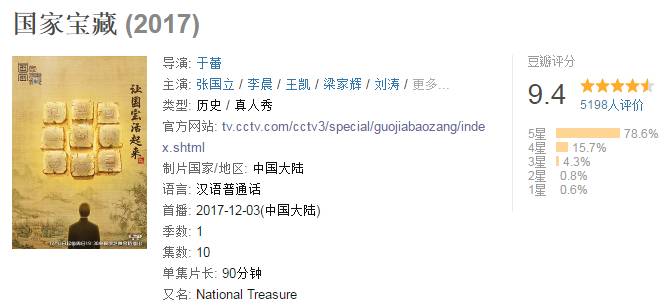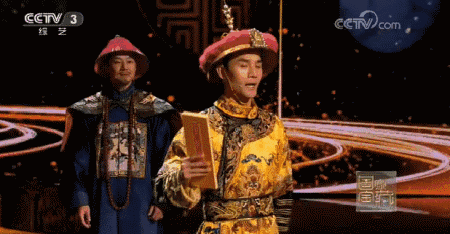Read English news every day!
A large-scale cultural exploration program
National Treasure
made its debut on Channel 3 of China Central Television on Sunday night.
In the first episode, the Palace Museum in Beijing showcases three treasures: a stone drum, painting
A Panorama of Rivers and Mountains
by Wang Ximeng and Large Vase with Variegated Glazes.

Famous actors Wang Kai, Li Chen and Tony Leung played roles of national treasure keepers, along with other actors, and narrated the treasures' legendary life journey and shared their stories with these treasures.

During the TV show, the nine major museums in China — the Palace Museum, Shanghai Museum, Nanjing Museum, Hunan Provincial Museum, Henan Museum, Shaanxi History Museum, Hubei Provincial Museum, Zhejiang Provincial Museum and Liaoning Provincial Museum — will each present three national treasures across its episodes.

As a cultural variety show, the
National Treasure
is dedicated to showcase the background stories of national treasures, and fuses various art forms including studio variety show, documentary and drama.
Each treasure in the show will be presented by "national treasure keepers" acted by celebrities and common people, to tell their stories with the collections, interpreting their historical mystery. The show aims to inspire the ancient Chinese civilization and make the national treasures "come alive".

Hong Kong actor Tony Leung, who called himself a "half Forbidden City man", spent much time in the Palace Museum when shooting the film
Reign Behind a Curtain
in which he played Emperor Xianfeng. This time, he is the keeper of the 2,300-year-old stone drum and acts as famous statesman Sima Guang in Northern Song Dynasty (960-1127) in the TV show.

Wang Kai, performing as Qing Dynasty (1644-1911) Emperor Qianlong in the show, presented the historical background of Large Vase with Variegated Glazes, which has the most complicated craftsmanship in the history of Chinese imperial porcelain.

Li Chen, acting as Emperor Huizong of the Song Dynasty (960-1279), tells the history of Wang Ximeng's precious painting
A Panorama of Rivers and Mountains
, which is rarely seen as each unfolding of the painting will have some mineral pigments peeled off.

This is not the first time for the Palace Museum in Beijing to go viral online in China, thanks to its efforts in cultural products and self-promotion in recent years.
Last year, the museum attracted so much attention because of the huge success of the three-episode TV documentary,
Masters in the Forbidden City
and a movie with the same name.

According to Shan Jixiang, curator of the Palace Museum, only 30 percent of the total area of the Forbidden City was open to the public 5 years ago. But in the last year, that figure has expanded to 76 percent. Now he is planning to open 80 percent of the palace's grounds to visitors by 2020.

Over the last few years, the museum has established 495 signposts and 1,400 new chairs have been provided. The palace has removed 11,200 square meters of its temporary buildings and provides cold light sources in the open halls.
In addition, the Palace Museum opened an official online store on e-commerce platform Taobao, selling related products. It also started their self-promotion through new media, publishing articles to promote the culture of the museum. It unexpectedly swept the Internet by its humorous style and interesting content.

The museum created over 7,000 kinds of cultural products in 2015, making a sales volume of 700 million yuan ($106 million) in the first half of the year, a figure larger than the total volume a year ago.
In 2016, it once again set a record, offering 8,700 kinds of products and achieving a sales volume of over 1 billion yuan.
At the same time, the Palace Museum has published several mobile apps, one of which saw over 200,000 downloads just two weeks after its release in 2013.
The Palace Museum has come closer to the people, sparing no efforts to promote itself among the public since 2013.
In the last month, a total of 18,529 themed calendars of the museum have been sold online. One buyer commented that buying the annual calendar has become routine for him.

Its self-promotion has achieved great results. In 2012, the museum saw 15 million visitors. Though the daily quota of visitors has been set at 80,000, the total number of tourists still keeps rising. The Palace Museum received 16 million visitors last year.
The museum is also a popular attraction among foreign leaders. For example, US President Donald Trump and his wife Melania Trump visited the Palace Museum on Nov 8.
Read more:
特朗普,来了!Trump's first day in China
What do you think of the protection of national treasures in China?
Sources: chinadaily.com.cn, people's daily
Editors: Zhang Xi, A Yimu (intern)
Click here for audio and translation of the story

Emojis on austerity rules from
top anti-graft authority go viral

World AIDS Day:
How much do you know about HIV/AIDS?






